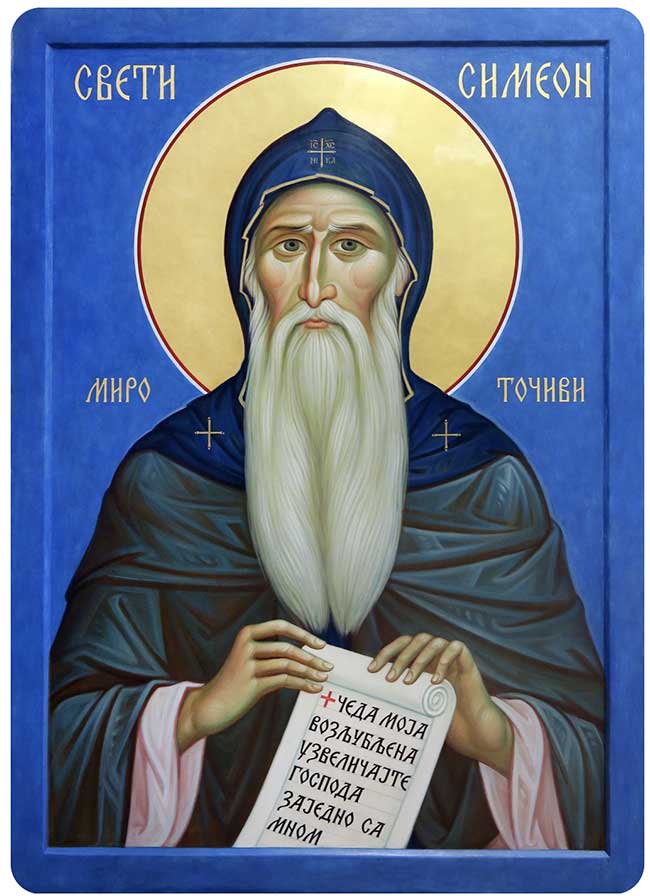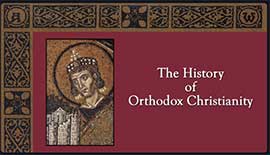STEFAN NEMANJA ABDICATED HIS THRONE TO HIS SECOND SON

[Above: Saint Symeon the Myrrh-Gusher, Founder of the Chilandar Monastery in Mount Athos [Athenogenes / Pinterest https://www.pinterest.com/pin/784118985122407734/]]
ON THIS DAY, 23 March 1196,* eighty-year-old Prince Stefan Nemanja of Serbia abdicated his throne to become a monk. At a sabor (council) held in Ras, he transferred authority to his second son, also named Stefan.
Nemanja had warred greatly over the decades. He got a rough start when three brothers ganged up to imprison him in a cave. After his escape, he defeated them, reconciled with the two still living (one had drowned), restored their lands, and pressed forward to unify Serbia. He added half of Kosovo to his territory. Backed by Venice, he also attempted to free Serbia from the Byzantine Empire. Although unsuccessful in two revolts, he managed to retain favor with the Byzantine emperors. (These few lines simplify events to the point of caricature. For example, Nemanji cooperated with Holy Roman Emperor Frederick Barbarossa against Byzantium in 1189 but also sometimes fought for the Byzantines.)
He took the Christian faith seriously, founding two monasteries and converting the Duklja region of his kingdom to Orthodoxy. However, his reign was marred by persecution of the Bogomil sect. He burned their books and exiled their adherents. Most took refuge in neighboring Bosnia. Bogomils believed that matter was created by the devil and therefore people should live as austerely as possible, avoiding meat, wine, marriage, and other “worldly” indulgences.
After his abdication, Nemanja took the name Symeon. He joined another son, Sava, at the famous monastic community at Mount Athos, Greece. There Symeon and Sava acquired a decayed monastery, Hilander (also transliterated “Chilander”), which they refurbished and expanded to house a Serbian religious community. Within a decade, its numbers had swelled to two hundred monks. Because of the monks’ learning, it became a cultural magnet for Serbia.
Nemanja died in February 1200. The church soon declared him a saint. He became known as Stefan Myrrh-gusher (or Symeon Myrrh-gusher) because his remains exuded the fragrant odor of myrrh. Sava transferred Nemanji’s relics to a Serbian church the king had beautified while still ruler: the Church of the Most Holy Theotokos on the River Studenitsa.
His sons proved themselves worthy successors. Sava became one of Serbia’s most famous saints and Stefan became a powerful king who added the rest of Kosovo to his territory. He was called “first crowned” because a papal legate, sent specially for the purpose, crowned him king. Despite this Roman connection, Stefan remained in the Eastern Orthodox camp, and even prevailed on the archbishop of Ohrid to allow Serbia to become autocephalous (that is, autonomous, having its own archbishop). The church also later declared King Stefan a saint.
No doubt having so many saints in the family tree helped establish the Nemanja dynasty, which produced powerful kings such as Milutin a century and a half later. The community at Hilander celebrates Stefan Myrrh-gusher’s memory each year on 26 February.
—Dan Graves
* - - - - - - -
I found as many dates for the abdication as I found sources, but all agree the event took place on the 23rd or 25th of March in either 1195 (O.S.) or 1196 (if the new calendar is retroactively followed). I have followed Fine’s date in The Late Medieval Balkans.
----- ------ ------
For an an in-depth look at the history and distinctive beliefs of the Orthodox Church watch The History of Orthodox Christianity
(The History of Orthodox Christianity can be purchased at Vision Video)
For more on Eastern Christianity read Christian History #54 Eastern Orthodoxy, then and now








